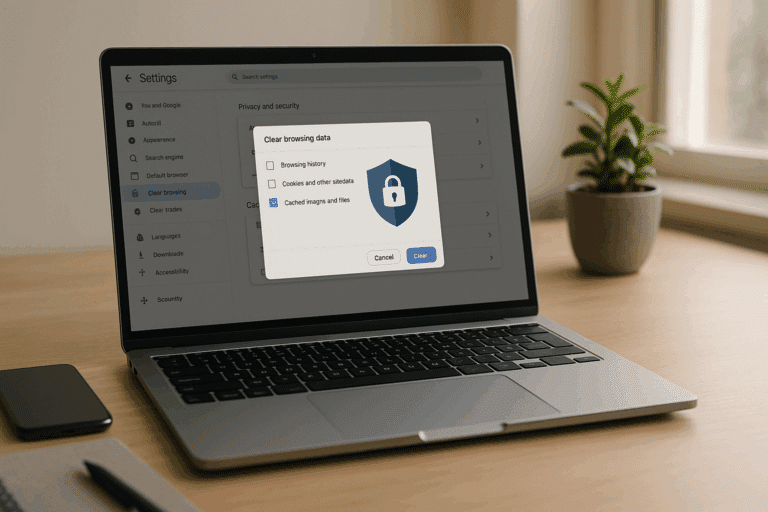😠 The disruption can be frustrating, not to mention the potential security risks associated with malicious ads. Does this scenario sound familiar? Welcome to the digital age where unwanted pop-ups and potential threats to your browsing experience have become, unfortunately, commonplace.
However, if you’ve stumbled upon this article, the chances are high that you’ve had enough and are seeking effective ways to say goodbye to malicious ads. You’re in the right place! In this comprehensive guide, we’ll equip you with the knowledge and tools necessary to block unwanted pop-ups and protect your browsing experience. 👍🏼
So why is this topic crucial? Just as we protect our physical spaces from unwanted intruders, our digital spaces deserve the same attention. Malicious ads can pose significant threats to our privacy and security, potentially leading to malware, ransomware, or phishing scams. By adopting proper measures to block these disruptions, we can navigate the digital realm with peace of mind. 😌
The internet is an indispensable tool in our daily lives, but it’s essential to know how to use it safely. That’s where this guide comes in. We’ll first delve into the nitty-gritty of what malicious ads are, how they work, and the threats they pose. Understanding the enemy is half the battle won, after all.
The Journey Ahead
In the subsequent sections, we’ll unravel the different types of ad-blockers and how to choose one that best suits your needs. We’ll also examine the steps you can take to protect your browsing experience, from changing browser settings to using secure networks. We’ll cover practical tips that you can apply immediately to ensure safer browsing. ⚙️
Not all pop-up ads are malicious, of course, but it’s a case of better safe than sorry. Therefore, we’ll also explore how to discern between harmless and harmful ads. This way, you can be more selective about the content you engage with online, reducing your chances of falling prey to nefarious cyber-activities. 🕵️♂️
As a bonus, we’ll conclude with a section on the ethical considerations around ad-blocking. After all, the internet is fueled by ads to a large extent, and it’s essential to strike a balance between protecting oneself and supporting content creators.
From the tech-savvy netizen to the average Joe, this guide is designed to be comprehensive and accessible to all. In the words of Sun Tzu, “If you know the enemy and know yourself, you need not fear the result of a hundred battles.” We aim to arm you with this knowledge to face the digital world head-on. 🛡️
Without further ado, let’s dive into the intricate world of ad-blocking and browser protection. Prepare to say goodbye to malicious ads, and hello to a safer, smoother browsing experience! 🚀
🛡️ Embarking on the Journey: Understanding Malicious Ads
Before we delve into the technicalities of blocking unwanted pop-ups, it is important to understand what constitutes a malicious ad. These are advertisements that are used as a platform for cybercriminals to spread malware or engage in phishing activities. They often appear innocuous, masquerading as legitimate ads. An article published by Fortinet revealed that nearly a quarter of all ad traffic in 2018 was considered suspicious. But how do you differentiate between a legitimate ad and a malicious one? 🕵️♂️
Malicious ads often employ scare tactics, alarming users about non-existent threats to their devices or personal information. They could also entice you with deals that seem too good to be true. The key is to remain vigilant and question the authenticity of any ad that seeks to evoke a strong reaction from you.
Given the gravity of the situation, this article aims to provide a comprehensive guide on how to effectively block these unwanted pop-ups, thereby ensuring a safe and secure browsing experience. Let’s dive in!
🛠️ Building Your Defense: Tools for Blocking Unwanted Ads
The first line of defense against malicious ads is pop-up blockers. These are tools that prevent pop-up windows from appearing on your screen. They can be standalone applications or built into your browser. Some of the most popular pop-up blockers include AdBlock, AdBlock Plus, Poper Blocker, and StopAd.
Each of these tools offers a different set of features. While some are free, others require a small fee for advanced features. To help you make an informed decision, we’ve compiled a comparative table of some of the most commonly used pop-up blockers:
| Pop-up Blocker | Price | Key Features |
|---|---|---|
| AdBlock | Free | Blocks all ads, Whitelist option, Customizable filters |
| AdBlock Plus | Free | Blocks all ads, Allows non-intrusive ads, Available on multiple platforms |
| Poper Blocker | Free | Blocks all pop-ups, Unique overlay control |
| StopAd | Paid | Blocks all ads, Advanced privacy features, 24/7 customer support |
While pop-up blockers are a great first step, they are not a catch-all solution. For comprehensive protection, you need to employ a mix of tools and strategies, which we will discuss in the following sections.
🔒 Doubling Down on Security: Advanced Strategies for Blocking Unwanted Ads
Beyond employing pop-up blockers, there are other advanced strategies to fortify your defenses against malicious ads. These involve adjusting your browser settings, installing antivirus software, and being proactive about updating your devices.
Most browsers, like Chrome, Firefox, and Safari, come with built-in pop-up blocking features. By simply adjusting your browser settings, you can significantly reduce the number of unwanted ads. For a detailed step-by-step guide on how to enable pop-up blocking on different browsers, check out this video: “How to Enable Pop-up Blocker on Chrome, Firefox, and Safari” by Geek’s Tutorial.
In addition to adjusting browser settings, installing an antivirus software is crucial. These software programs can detect and eliminate threats before they harm your system. Some recommended antivirus software programs include Avast, Norton, and McAfee. They not only provide real-time threat detection but also offer features like secure VPN, password management, and safe browsing tools.
Last but not least, always ensure your devices and software are updated to the latest versions. Updates often include patches for security vulnerabilities that could be exploited by cybercriminals. Staying updated is one of the simplest, yet most effective, ways to protect yourself from unwanted ads and cyber threats.
🎯 Taking Control: Educating Yourself and Others
While the tools and strategies discussed above can significantly reduce the risk of encountering malicious ads, the most powerful weapon in your arsenal is knowledge. Educating yourself and others about the dangers of malicious ads and how to identify them can make a world of difference.
Invest time in understanding the common signs of malicious ads such as poor grammar, misspellings, or unprofessional design. Be wary of ads that ask for personal information or prompt you to download a file. It’s also a good idea to familiarize yourself with the common types of online scams.
Remember, the internet is a shared space. Your actions can directly impact others. By practicing safe browsing habits and educating those around you, you can contribute to a safer and more secure online community.
🔮 Looking Forward: The Future of Online Advertising and Security
The world of online advertising is constantly evolving, with new technologies and tactics emerging all the time. This means that the strategies for blocking unwanted ads need to evolve as well. Artificial Intelligence (AI) and Machine Learning (ML) are increasingly being used to detect and block malicious ads. These technologies promise to add a new layer of security, making the internet a safer place for users.
However, the fight against malicious ads is not one that can be won solely through technological advancements. It requires a combined effort from individuals, tech companies, and regulatory bodies. As users, we must stay informed and vigilant. Tech companies need to prioritize user safety and privacy, and regulatory bodies must enforce stricter policies for online advertising.
The road ahead may seem daunting, but with the right tools, knowledge, and a collective effort, we can look forward to a future where unwanted pop-ups and malicious ads are a thing of the past. The power to change the future of online advertising and security is in our hands. Let’s use it wisely! 👨💻👩💻

Conclusion
In conclusion, we have traversed through a rich and technical terrain that has enlightened us on some of the most complex concepts related to Information Technology and engineering. As we have noted, these domains are not a walk in the park, but with a strategic approach, the inherent complexities can be unraveled, and the underlying principles understood in simpler terms.
We began by dissecting the multifaceted realm of software engineering, providing an in-depth understanding of the discipline. It is paramount to highlight the crucial role software engineering plays in our increasingly digital society. Understanding software engineering principles is not only beneficial to those in the IT and engineering fields, but also to anyone using software, as it helps to demystify the technology that runs our world. 🌍💻
Subsequently, we delved into the intricacies of writing technical documents, an area that I am well-versed in and passionate about. Technical writing, as we have learned, plays an integral role in ensuring that complex concepts are communicated effectively. Despite its inherent challenges, technical writing is not an insurmountable task. With the right skills, anyone can become a proficient technical writer. 📝🎯
It is my hope that this comprehensive guide has been insightful, and that you have been able to gain a deeper understanding of these key concepts. I encourage you to further explore these areas, given their relevance in our present-day society. To assist in this endeavor, here are a few helpful resources that you might find useful:
1. W3Schools: This is an excellent resource for learning about software engineering and technical writing.
2. Coursera: Here, you can take courses on a variety of technical topics, including software engineering and technical writing.
Remember, knowledge is power! 💪🧠
Lastly, I cannot overemphasize the importance of sharing this knowledge. As professionals in our respective fields, we have a responsibility to share what we know, to help others grow and understand these complex domains. Feel free to share this article with your colleagues, or anyone who might find it useful.
If you have any comments or suggestions, please feel free to share them. Your feedback is highly valued and helps in creating content that is informative, relevant, and beneficial to all.
Thank you for taking the time to read this comprehensive guide, and remember, stay curious, keep learning, and don’t forget to share! 📚🚀
[wp_social_sharing social_options=’facebook,twitter,googleplus,linkedin,pinterest’ facebook_text=’Share on Facebook’ twitter_text=’Share on Twitter’ googleplus_text=’Share on Google+’ linkedin_text=’Share on Linkedin’ pinterest_text=’Share on Pinterest’ icon_order=’f,t,g,l,p’ show_icons=’1′ before_button_text=” text_position=” social_image=”]



